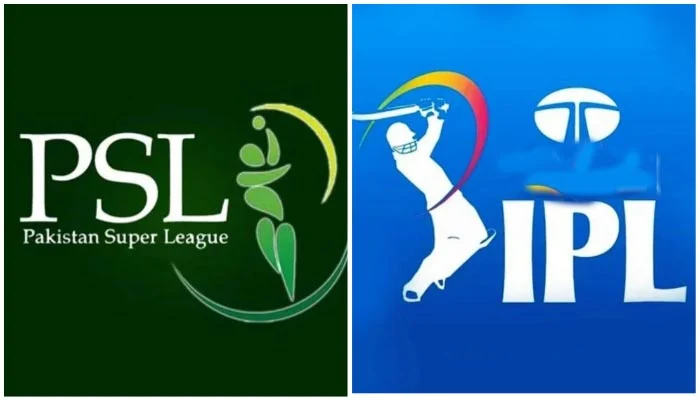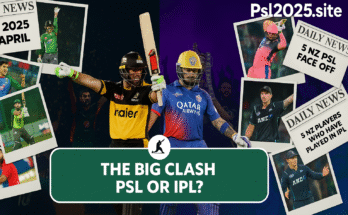PSL 2025 vs IPL 2025: The Battle for Fan Loyalty and Digital Dominance
As the Pakistan Super League (PSL) and Indian Premier League (IPL) collide in an unprecedented scheduling overlap from April to May 2025, the cricketing world is witnessing more than just a clash of on-field talent. Running from April 11 to May 18, the PSL’s 10th season, with its 34 matches across four Pakistani cities, faces off against the IPL’s 18th season, featuring 74 matches from March 22 to May 25. Beyond the boundary, this clash is a battle for fan loyalty, digital engagement, and marketing supremacy. With the IPL’s global dominance and the PSL’s passionate domestic base, which league will capture hearts, clicks, and trends in 2025? This article dives into the fan culture, social media strategies, and marketing innovations driving both leagues, exploring whether the PSL can shine in this high-stakes rivalry.
Fan Culture: Passion vs. Glamour
The PSL and IPL boast distinct fan cultures that reflect their respective cricketing ecosystems. The PSL’s fanbase is deeply rooted in Pakistan’s cricket-crazed populace, with supporters known for their unwavering loyalty and emotional investment. Cities like Lahore, Karachi, and Multan transform into vibrant hubs during the PSL, with stadiums packed despite challenges like boycott campaigns targeting sponsors such as KFC and Pepsi over Pro-Palestinian sentiments. The PSL’s “HBL PSL X” campaign, including the nationwide Luminara Trophy tour, has galvanized fans, bringing the trophy to schools, malls, and public spaces across Pakistan for the first time. This grassroots approach fosters a sense of ownership, as fans chant slogans like “Zalmi Zalmi” or “Dil Se Jaan Se” for teams like Peshawar Zalmi and Lahore Qalandars.
In contrast, the IPL’s fan culture blends cricket with Bollywood glamour, attracting a global audience. Franchises like Mumbai Indians and Chennai Super Kings command cult-like followings, fueled by star players like Rohit Sharma and MS Dhoni, and celebrity owners like Shah Rukh Khan. IPL matches are spectacles, with packed stadiums, cheerleaders, and post-match concerts. The IPL’s fan engagement extends beyond India, with significant viewership in markets like the UAE, UK, and Australia. Its 620 million viewers in 2024 dwarf the PSL’s 150 million digital views, but the PSL’s fans argue their passion is unmatched, as seen in viral X posts like @CricketFanPK’s claim: “PSL crowds bring energy IPL can only dream of.”
Digital Engagement: Social Media Showdown
In the digital arena, both leagues are leveraging platforms like X, Instagram, and YouTube to capture attention during the 2025 clash. The IPL’s social media presence is a juggernaut, with franchises boasting millions of followers. Mumbai Indians, with over 13 million Instagram followers, and Royal Challengers Bengaluru, with 11 million, post slick highlights, player reels, and behind-the-scenes content. The IPL’s official X account, with 10 million followers, drives engagement through live updates, polls, and memes, often trending globally during matches. Hashtags like #IPL2025 and #VivoIPL dominate conversations, amplified by sponsors like Tata and Jio.
The PSL, while smaller, punches above its weight digitally. Its official X account, with 2.5 million followers, and team accounts like Karachi Kings (1.2 million) engage fans with localized content, including Urdu captions and patriotic themes. The PSL’s anthem “X Dekho,” featuring Atif Aslam, trended on YouTube with 5 million views within days of release, rivaling the IPL’s anthem launch. The PSL’s digital strategy emphasizes authenticity, with fan-generated content like #PSLX and #HBLPSL trending on X. Posts from users like @PSLFanatic, praising Islamabad United’s unbeaten run, highlight the league’s ability to spark organic buzz. However, the PSL faces challenges, as boycott-related hashtags like #BoycottPSLSponsors occasionally overshadow positive trends.
YouTube is a key battleground, with both leagues eyeing thumbnail-driven clicks. The PSL’s official channel uploads match highlights, player interviews, and vlogs, optimized for 1280×720-pixel thumbnails featuring stars like Babar Azam or the Luminara Trophy. The IPL’s channel, with 10 million subscribers, posts high-production content, from drone-shot stadium visuals to “Inside IPL” documentaries. Both leagues use clickbait-style thumbnails—bold text, vibrant colors, and action shots—but the IPL’s larger budget ensures glossier visuals. Still, the PSL’s raw, fan-driven content resonates, as seen in viral clips of Shaheen Afridi’s fiery spells.
Marketing Strategies: Innovation vs. Scale
The IPL’s marketing is a masterclass in scale, backed by a $6.2 billion media rights deal and sponsors like Tata, Dream11, and Paytm. Its 2025 campaign, centered on “Bigger, Bolder, Better,” includes AR filters, fantasy leagues, and partnerships with global brands. The IPL’s opening ceremony at Eden Gardens, featuring AR Rahman and Ranveer Singh, is expected to draw 50 million viewers. Franchise merchandise, from jerseys to NFTs, generates millions, with Chennai Super Kings’ yellow kits a global bestseller. The IPL’s ticketing platform, integrated with Paytm, ensures seamless sales, filling 50,000-seat venues.
The PSL’s marketing, while leaner, is innovative. With a $36 million broadcast deal involving PTV Sports, A Sports, and Walee Technologies, the PCB has prioritized accessibility, streaming matches on platforms like Tamasha and Tapmad. The Luminara Trophy, unveiled in a star-studded Karachi ceremony, symbolizes the PSL’s ambition, with its name—meaning “light” in Latin—reflecting hope and unity. The trophy tour, covering 10 cities, has boosted engagement, with fans sharing selfies on X using #PSLX. The PSL’s merchandise, like Quetta Gladiators’ purple caps, is popular locally but lacks the IPL’s global reach. Ticket prices, starting at PKR 500, make matches affordable, though boycotts have led to partially empty stands in Multan.
Sponsorship strategies differ significantly. The IPL’s title sponsor, Tata, and associate brands like RuPay dominate advertising, with in-stadium LED boards and jersey logos. The PSL’s title sponsor, HBL, and partners like KFC face scrutiny due to boycott campaigns, prompting creative pivots like fan contests and digital ads. The PSL’s “Fan of the Match” initiative, rewarding vocal supporters with prizes, has trended on X, countering negative sentiment.
Challenges and Opportunities
The scheduling clash poses challenges for both leagues. The IPL risks viewer fatigue with its 74-match marathon, especially if fans split attention with the PSL. Its reliance on star power could falter if injuries or form dips affect players like Virat Kohli. The PSL, meanwhile, struggles with financial constraints and boycott-related PR issues. Empty seats in matches like Multan Sultans vs. Lahore Qalandars have sparked criticism on X, with @SportsAnalystPK noting, “PSL needs to address attendance to compete with IPL’s packed houses.”
Yet, opportunities abound. The PSL’s compact 34-match format ensures every game matters, unlike the IPL’s occasionally bloated schedule. Its bowling-heavy matches, like Peshawar Zalmi’s defense of 140 against Karachi Kings, offer a contrast to the IPL’s 200+ run-fests. The PSL can capitalize on its domestic stars—Babar Azam, Shaheen Afridi—and new signings like David Warner to draw international viewers. The IPL, with its global appeal, can deepen engagement through innovations like VR match experiences, but risks alienating fans if ticket prices (starting at INR 1000) rise further.
The Verdict: Can PSL Shine?
The PSL’s ability to shine hinges on its fan-centric approach and digital agility. By leveraging its passionate fanbase, authentic content, and affordable ticketing, it can retain domestic loyalty and grow internationally. The Luminara Trophy tour and anthem have set a strong tone, and strategic match timings (8:00 PM PKT) avoid IPL clashes. However, the IPL’s scale—financial, digital, and cultural—gives it an edge in global dominance. Its polished marketing and star-studded events ensure it remains the T20 gold standard.
Ultimately, the PSL doesn’t need to outshine the IPL to succeed. By focusing on quality cricket, fan engagement, and cultural resonance, it can carve a niche as a gritty, competitive alternative. As @CricketGuru on X put it, “IPL has money, but PSL has heart.” In this battle for fan loyalty and digital dominance, both leagues can coexist, with the PSL proving that passion and innovation can light up the cricketing world, even in the IPL’s shadow.

